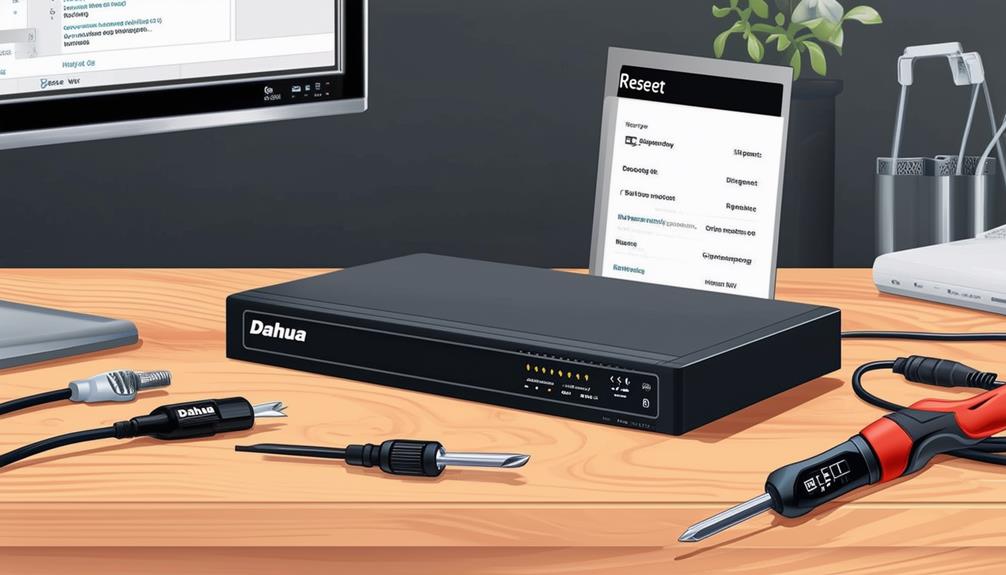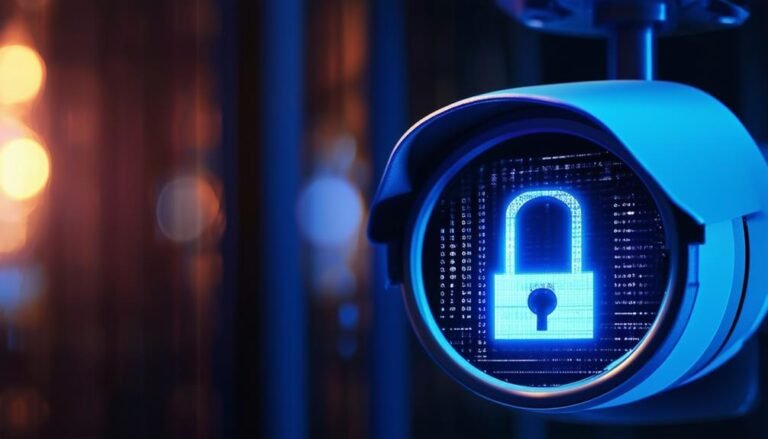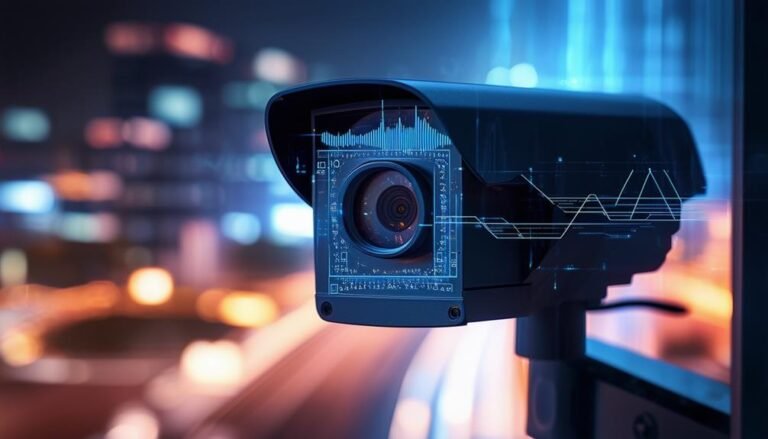To factory reset your Dahua NVR, first, back up any important data and document your current settings. Connect to the device using its default IP address, usually 192.168.1.108. Log in with your credentials, typically ‘admin’ and ‘admin’ or ‘123456’. Navigate to the ‘System’ or ‘Configuration’ section in the main menu and locate the ‘Factory Reset’ option. Confirm your choice, and the system will reboot. After the reset, you’ll need to reconfigure your NVR to suit your needs. There’s more to optimize your setup and avoid pitfalls in your next steps.
Understanding Dahua NVR
Understanding Dahua NVRs begins with recognizing their role in modern surveillance systems. These Network Video Recorders are essential for anyone looking to maintain security and control over their environment. By allowing you to record, store, and manage video footage from multiple cameras, Dahua NVRs empower you to take charge of your safety. With wireless capabilities, you can monitor your property from anywhere, giving you that sense of freedom and peace of mind.
Whether you’re keeping an eye on your home, business, or a public space, Dahua NVRs provide the flexibility to adapt to your unique needs. You can customize your surveillance setup, integrating various cameras and features that best serve your purpose. This adaptability is vital in a world where personal security is paramount, allowing you to tailor your system to fit your lifestyle.
Dahua NVRs also come equipped with user-friendly interfaces, making it easy for you to navigate through settings and configurations. You don’t need to be a tech expert to set up your surveillance system; it’s designed for accessibility. Additionally, these devices offer advanced features like motion detection and alerts, ensuring you’re always aware of what’s happening in your surroundings.
In essence, Dahua NVRs are more than just recording devices; they’re powerful tools that give you the autonomy to manage your security effectively. With the right setup, you can feel confident and liberated, knowing you’re taking proactive steps to safeguard what matters most to you.
Reasons for Factory Reset
Factory resetting your Dahua NVR can be essential for a few reasons. You might want to restore default settings, resolve persistent technical issues, or clear any user data that’s no longer needed. Understanding these reasons can help you decide when a reset is the best option for your device.
Restore Default Settings
Occasionally, you might find yourself needing to restore the default settings on your Dahua NVR. This process can be essential for various reasons, and understanding when to take this step can help you regain control. Here are a few reasons you might consider a factory reset:
- Configuration Errors: If you’ve made changes that aren’t working, a reset can clear the confusion.
- Security Concerns: If you suspect unauthorized access or compromised settings, restoring defaults can enhance your system’s security.
- Upgrading or Selling: Before handing off your device, resetting it guarantees that your personal data and configurations are wiped clean.
Restoring default settings can feel liberating, allowing you to start fresh without the clutter of previous configurations. It’s a chance to create an environment that meets your current needs. Remember, though, this process will erase all custom settings, so be sure to back up any important configurations before proceeding. Freedom in managing your NVR starts with understanding when and why to reset it, empowering you to maintain a system that truly reflects your requirements.
Resolve Technical Issues
If you’re facing persistent technical issues with your Dahua NVR, a factory reset might be the solution you need. Sometimes, glitches or system errors can lead to frustrating experiences, like losing video feeds or having trouble accessing settings. Instead of letting these problems hinder your surveillance capabilities, consider a reset to restore functionality.
A factory reset can clear out any corrupted files or configurations that may have developed over time. If your NVR is freezing, lagging, or displaying error messages, resetting it to its original state can often resolve these concerns. This process fundamentally wipes the slate clean, giving you a fresh start and allowing you to reconfigure the system as per your needs.
Additionally, if you’ve recently made updates or changes that didn’t go as planned, a reset can help you revert to a stable operating environment. It’s a straightforward way to reclaim control over your security system and guarantee it operates smoothly. So, before you throw in the towel or seek professional help, consider a factory reset. It might just be the freedom your Dahua NVR needs to operate at its best again.
Clear User Data
Clearing user data is one of the primary reasons for performing a factory reset on your Dahua NVR. When you decide to take control and wipe the slate clean, you’re choosing to liberate your system from unwanted clutter. This can be essential for various reasons, including enhancing performance and ensuring your privacy.
Here are a few key benefits of clearing user data:
- Boost Performance: A fresh start can lead to improved responsiveness and efficiency.
- Enhance Security: Removing old data helps protect your system from unauthorized access and potential breaches.
- Prepare for New Configurations: If you’re planning to change your setup, clearing old settings can make the shift smoother.
Preparing for the Reset
Before diving into the factory reset process for your Dahua NVR, it’s vital to confirm you’re fully prepared. A factory reset can wipe out all your settings and data, so taking a few precautionary steps is important for guaranteeing a smooth experience. Here’s what you should consider before proceeding:
- Backup Important Data: If you’ve got any significant recordings or configurations, make sure to back them up. This’ll save you from losing valuable footage or settings.
- Document Your Current Settings: Write down your existing settings. This’ll help you restore your configurations after the reset if needed.
- Check Power Supply: Confirm your NVR is connected to a reliable power source. A sudden power cut during the reset can cause issues.
- Review User Permissions: Make sure you know who has access to the NVR. After the reset, you’ll want to re-establish permissions for users.
- Gather Required Tools: Depending on your model, you might need specific tools to perform the reset. Have them ready to avoid delays.
Here’s a quick checklist to help you prepare:
| Step | Action Required |
|---|---|
| Backup Data | Save recordings/settings |
| Document Settings | Write down configurations |
| Check Power Supply | Confirm stable connection |
| Review User Permissions | Know access levels |
| Gather Required Tools | Collect necessary tools |
Accessing the NVR Interface
To access the NVR interface, you’ll need to know the default IP address of your device. Once you’re connected, make sure you have the correct login credentials handy, as they’re required to get in. This step is essential for managing your NVR settings effectively.
Default IP Address
Accessing the Dahua NVR interface requires knowing its default IP address, which is typically set to 192.168.1.108. This address is your gateway to managing your network video recorder, allowing you to configure settings and monitor your surveillance system. To guarantee a smooth experience, keep these tips in mind:
- Connect to the Right Network: Make sure your computer is on the same subnet as the NVR.
- Use a Compatible Browser: Some browsers may not support the NVR interface properly, so consider using Internet Explorer or a recommended browser.
- Configure Your Computer’s IP: Set your computer’s IP address to something like 192.168.1.100 to stay within the same range.
Once you’ve established a connection, you can enter the default IP address into your web browser’s address bar. This will lead you to the NVR interface, where you can explore and customize your surveillance setup. Remember, understanding this process gives you the freedom to take control of your security system. Embrace the technology, and enjoy the peace of mind it brings!
Login Credentials Required
Upon reaching the Dahua NVR interface, you’ll need to enter the correct login credentials to gain access. This step is essential, as it guarantees your surveillance system remains secure and private. If you’re enthusiastic to explore the features and take full control of your NVR, knowing the default username and password is important.
Here’s a simple table to help you understand common login credentials:
| Username | Password |
|---|---|
| admin | admin |
| admin | 123456 |
| user | 1234 |
| operator | operator |
| guest | guest |
If you’ve changed the default credentials and forgotten them, you’ll need to reset the device to regain access. Remember, securing your NVR is crucial for protecting your freedom and privacy. Once you log in, you can customize your settings, manage cameras, and monitor your premises effectively. Your NVR becomes a powerful tool for safeguarding what matters most to you, allowing you to reclaim your peace of mind. So, make sure you have those credentials handy to access the full potential of your Dahua NVR!
Navigating to Reset Options
Finding the reset options on your Dahua NVR is a straightforward process that can save you time and frustration. Once you’re logged in, you’ll notice that the interface is designed to help you navigate easily to the settings you need. Here’s how to find the reset options quickly:
- Access the Main Menu: Look for the icon that represents the main menu, often found at the bottom of your screen.
- Go to System Settings: Once the main menu is open, locate the ‘System’ or ‘Configuration’ section. This is usually where you’ll find the reset options hidden away.
- Find the Reset Options: Within the System Settings, look for an option labeled ‘Restore Default’ or ‘Factory Reset.’
Remember, the layout may vary slightly depending on your NVR model, but the general steps remain consistent. If you’re struggling to find the options, don’t hesitate to consult the user manual or online resources specific to your model.
The freedom of managing your NVR lies in knowing how to access these settings. A quick reset can often resolve issues that disrupt your surveillance flow. So take a moment to familiarize yourself with the interface and navigate confidently to the reset options. You’ll be one step closer to regaining control and ensuring your security system runs smoothly.
Performing the Factory Reset
Now that you’ve located the reset options, it’s time to perform the factory reset on your Dahua NVR. This process will wipe all settings and configurations, returning the device to its default state. Before you proceed, make sure you’ve backed up any important data, as this step is irreversible.
To start the factory reset, follow these simple steps:
- Go to the reset menu you found earlier.
- Choose the option labeled “Factory Reset” or something similar.
- Confirm your choice when prompted.
You’ll see a message indicating that the reset is in progress. Give it a moment, and once it’s complete, the NVR will reboot.
Here’s a handy table summarizing the steps for clarity:
| Step Number | Action | Notes |
|---|---|---|
| 1 | Access Reset Menu | Navigate through the interface |
| 2 | Select Factory Reset | Look for the option clearly labeled |
| 3 | Confirm Reset | Be aware that this is irreversible |
| 4 | Wait for Reboot | Allow the system to restart |
Reconfiguring Your NVR
How do you get your Dahua NVR back up and running after a factory reset? Reconfiguring your system might seem intimidating, but it’s all about reclaiming control over your surveillance setup. Once you’ve completed the factory reset, follow these essential steps to guarantee everything’s tailored to your needs.
- Connect to the Network: Make sure your NVR is connected to the internet or local network. This will enable remote access and the ability to add cameras.
- Set Up User Accounts: Create user accounts with appropriate permissions. You want to manage who can access your system effectively.
- Configure Camera Settings: Add and configure your cameras, ensuring they’re aligned with your security objectives.
Now that you’ve got the basics covered, immerse yourself in the NVR menu. You’ll want to access the settings and adjust parameters like resolution, recording schedules, and motion detection. It’s your chance to personalize the system based on your specific surveillance needs.
Don’t forget to save your settings after each adjustment. There’s nothing worse than losing all that hard work due to a simple oversight. Remember, this is about empowering yourself and guaranteeing that your security setup fits seamlessly into your life.
Once you’ve reconfigured everything to your liking, take a moment to test the system. Make sure all cameras are functioning correctly and that you can access your NVR remotely. Enjoy the freedom of knowing your space is secure!
Restoring Previous Settings
Restoring previous settings on your Dahua NVR can streamline the reconfiguration process and save you valuable time. If you’ve backed up your settings before performing a factory reset, you can easily restore them to regain your preferred configurations. This approach not only eases the shift but also guarantees you maintain the security and functionality you’re used to.
To start, locate the backup file you created prior to the reset. This file typically contains all your crucial configurations, including network settings, camera setups, and recording schedules. Once you’ve found the backup file, log in to your Dahua NVR with your admin credentials. Navigate to the “Settings” menu and look for the “System” or “Configuration” section. Here, you should find an option to restore settings or import your backup file.
When prompted, select the backup file and confirm the restoration process. Your NVR will automatically apply the settings, bringing your device back to its previous state. Keep an eye on the progress bar or notification to guarantee the restoration completes successfully.
After restoring your settings, it’s a good idea to double-check each configuration to make sure everything’s in order. This way, you can verify that your NVR is running smoothly and efficiently. By restoring your previous settings, you can regain control over your security system without the hassle of starting from scratch. Enjoy the freedom that comes with a properly configured Dahua NVR!
Troubleshooting Post-Reset Issues
After a factory reset, you might encounter a few issues with your Dahua NVR that can disrupt your security setup. It’s crucial to address these problems promptly to regain control of your system. Here are some common post-reset issues you might face:
- Network Connectivity Problems: Your NVR may not automatically reconnect to your network, leaving you unable to access it remotely.
- Camera Recognition Issues: The cameras might not be recognized after the reset, requiring a reconfiguration to guarantee they’re all connected.
- Default Settings Confusion: You could find yourself struggling with the NVR’s default settings, which may not align with your original preferences.
To troubleshoot these issues, start by checking your network settings. Make sure the NVR is properly connected to your router and that you’ve entered the correct IP address. If you’re still having trouble, restarting both the NVR and the router can sometimes resolve connectivity problems.
For camera recognition, navigate to the camera management section and re-add your cameras manually. This step can be tedious but is often necessary after a reset.
Lastly, familiarize yourself with the default settings. You may need to reconfigure the NVR’s preferences such as recording schedules and alert configurations.
Frequently Asked Questions
Can I Factory Reset My Dahua NVR Remotely?
You can’t typically factory reset your NVR remotely. Most devices require physical access for a reset, ensuring security and preventing unwanted changes. If you’re looking for more control and freedom over your system, consider setting up remote management features in advance. That way, you can handle settings without needing to be on-site. Always keep your firmware updated and maintain secure access to safeguard your system from unauthorized resets or changes.
Will a Factory Reset Remove All Recorded Footage?
When you hit the reset button, it’s like cleaning your slate, but it comes at a cost. Yes, a factory reset will wipe out all recorded footage, just like erasing memories from a journal. You’ll regain control and start fresh, but you’ll lose valuable moments captured on your device. So, before you reset, consider backing up your recordings, ensuring you don’t sacrifice important memories for a clean start.
How Long Does a Factory Reset Take?
When you’re thinking about a factory reset, you might wonder how long it’ll take. Typically, it doesn’t take long—usually around 5 to 10 minutes. However, the exact duration can vary based on the device’s model and the amount of data stored. It’s a quick process, but make sure you have everything backed up if you need it, as resetting can clear your settings and data completely. Take that time to breathe and reset!
Do I Need a Password to Reset the NVR?
When you think about resetting your NVR, imagine opening a door to freedom. You might wonder if you need a password for that reset. Typically, yes, you’ll need the admin password to access the reset options. Without it, you could feel trapped, unable to regain control of your device. If you’re locked out, consider reaching out to support for help. Remember, every problem has a solution waiting just around the corner!
Will My Device Warranty Be Affected by a Factory Reset?
When you factory reset your device, it typically won’t void your warranty. Most manufacturers understand that users might need to reset their devices for various reasons. However, it’s always a good idea to check your warranty terms just to be safe. If you’re unsure, contacting customer support can clarify any concerns you have. So, go ahead, reset if you need to, and enjoy the freedom of a fresh start!



